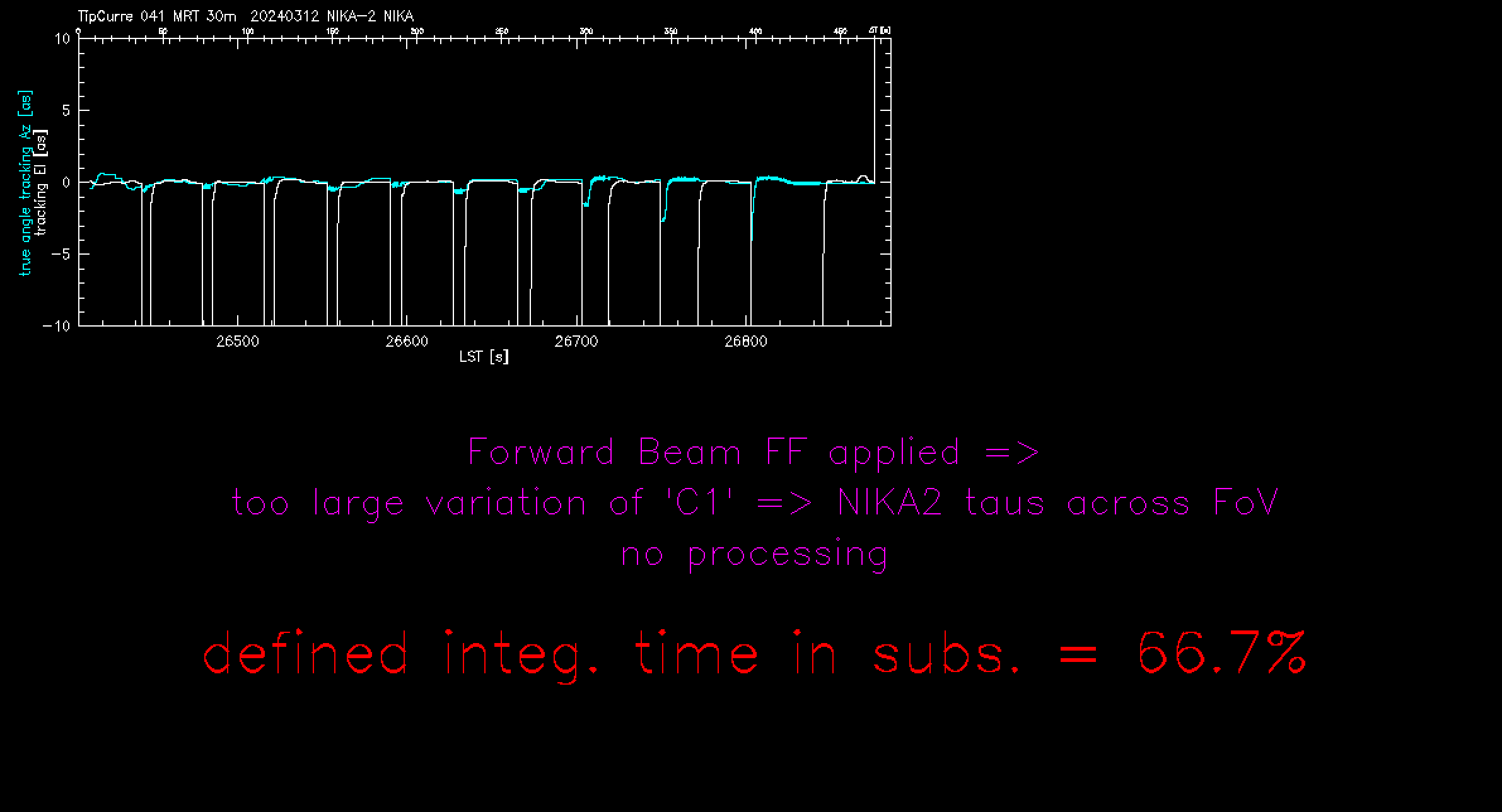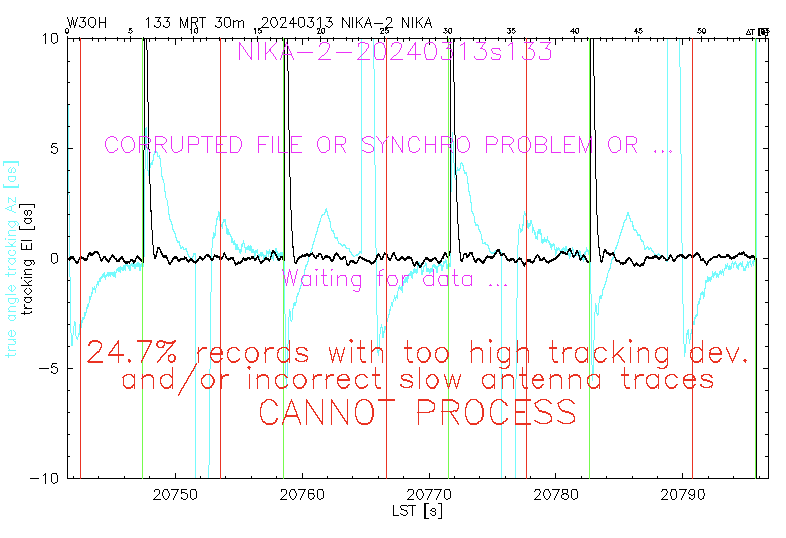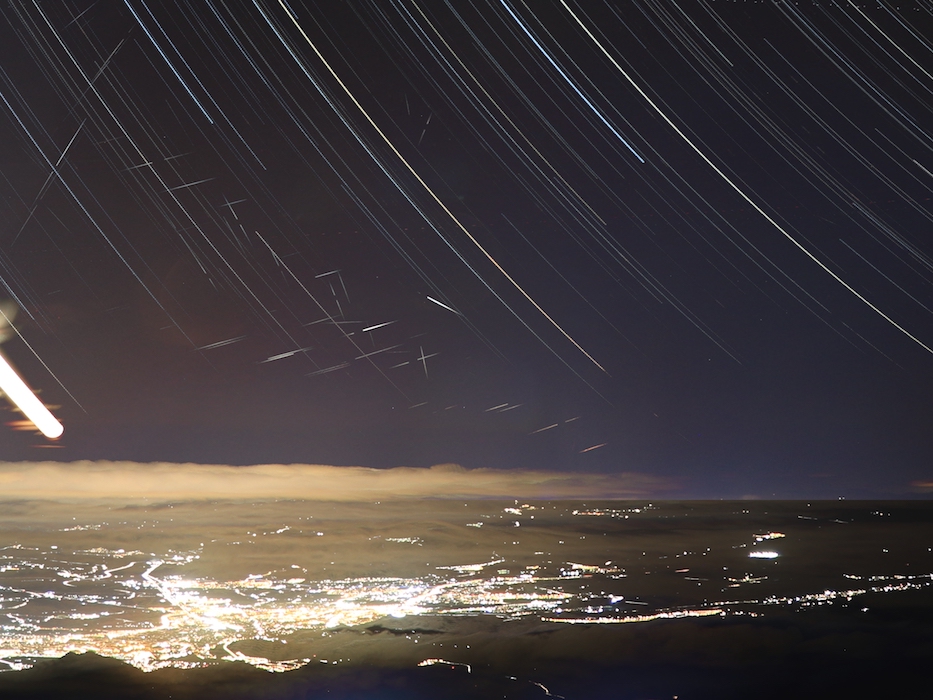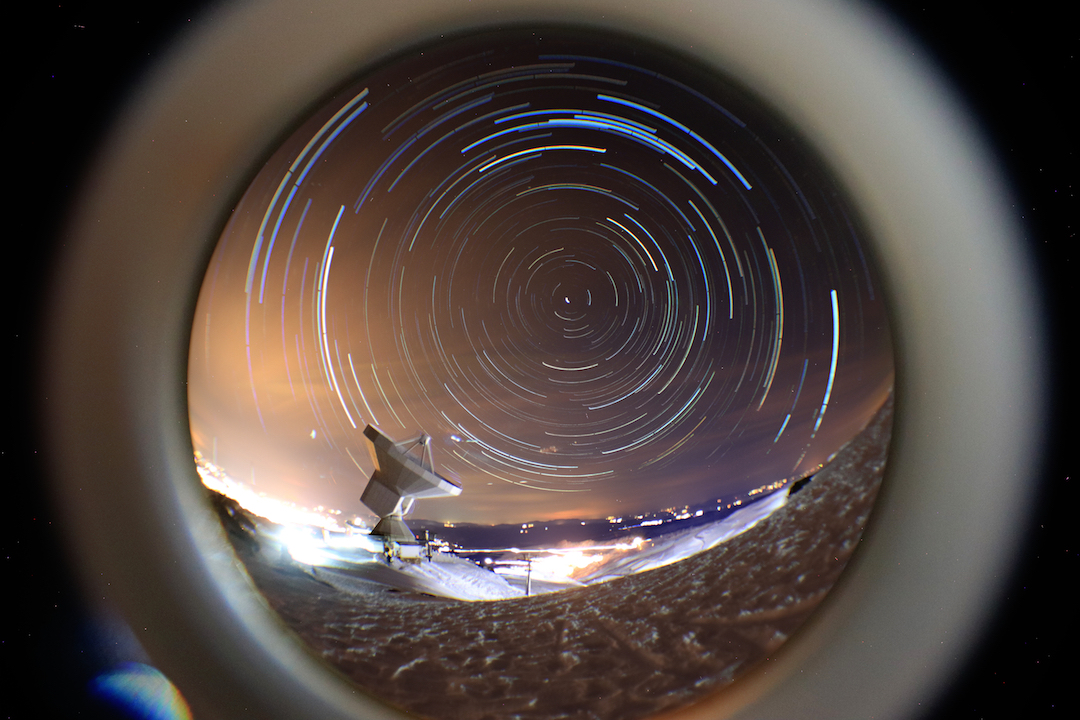Daily Reports
Contents
2024 Mar. 12th, Tuesday
Federico, Giovanni, Lea, Ste B. and Stergios at the telescope since ~10:30 (hereafter, local time), Quang in remote.
16:00-22:00; Stergios: maintenance finished around 16:00. We started with EMIR test observations with Ignacio testing the lateral focus at Uranus. The observations fail indicating a problem with ACU/spindles. The plan to perform lateral focus with NIKA2 around midnight is cancelled. At 17:12 we switch to NIKA and performed the DAQ with final values of bad pixels of 16/1/49 for the Ar1,2 and 3, respectively. KIDS are tuned properly, imbfits are created with the delay we observed the past weeks. We continued with calibration observations and moved to project 117-23 (orion) performing the 5th and 6th map repetitions. After sunset we moved to Uranus again for pointing, focus, calib_1scan, beam map and skydip (check the screenshot below for a weird skydip result from PIIC). Beam map was performed at ~40 deg of elevation, not optimal but we agreed to take more maps during the night. We performed another DAQ at 21:20 with 16/1/37 bad pixels for the Ar1,2 and 3, respectively. We continued with the project 138-23 that requires 3 hours to finalize. Another DAQ performed shortly after due to weird KID behavior (new bad pixels count: 31/3/38). At 21:42 we started the observations of NGC4214. Stefano and Lea take over.
A shy Moon and Jupiter set on Granada

It's a beautiful day on Pico Veleta
22:00-06:00; Stefano/Lea:
We take over at 21 UT as planned, and we continue observing project 138-23.
At 21:50 UT, we test the custom make-imbf, designed to run several instances of make-imbf in parallel. Bilal has kindly pointed SB to these scripts. We have edited them to adapt them to cryo run 78, but it's not been enough: it does not seem to start properly. Probably more editing might be needed. Therefore we switch back to the standard make-imbf, to avoid wasting time. Total amount of time lost: 10 minutes. Later we noticed that we might have been too impatient and maybe the custom make-imbf actually really started its job, but SB decided to kill it too early. We might try again later during calibrations or tomorrow.
During the whole night, we observe:
- 8 repetitions of NGC4214 for project 138-23 (2h in total)
2 repetitions of A2623 for project 153-23 (>~1h in total)
- beam-map on 1226+023 (scan 20240313s26), option "a". Followed by a skydip.
4 repetitions of NGC4214 for project 138-23 (1h in total) -> target completed! (total 13.2h)
- 1 repetition of A2747 for project 153-23
@4:45 UT we have to park the telescope because wind gusts reached 21 m/s
2024 Mar. 13th, Wednesday
06:00-12:00; Quang, Stergios: Around 6:00 we parked the antenna due to high wind (gusts of up to 20m/s).Started the DAQ around 7:00 (bad KIDS 28/3/41). We lost a couple of times the access to the remote screens. Wind increased again until 9:00 where the wind dropped significantly. DAQ shows 18/2/36 bad pixels. The issue with the screens persists (PM was contacted and fixed the problem). IR checked the Sun avoidance and it worked however the cost was to heat the antenna. We started finally the observations at 9:42 using Mars as calibrator and observing project 151-23 until the end of the shift. No polarimetry observations were performed.
12:00-14:00; Federico: Found problem in the current position of the telescope with respect to the source position in XEPHEM for the ongoing observation of PSZ2G066, project 151. The telescope is not pointing on the source! We restart XEPHEM, problem remains. We cancel the current observation (3 scans in tapas, ids: 63 to 65) and did a test pointing in nikaw account on a nearby source (1800+440). The problem persists: the position of the telescope in XEPHEM and in the operator monitors does not coincide with the location of the source in XEPHEM, but we have the source at the centre of the FOV. In the meantime we check the problem with experts, we tried again with observations of PSZ2G066 (in the 151-23 account), but the problem persist (and we cancelled the observation queue, test done ids: 66, 68,69,70,71). A missing "0" in the dec value (i.e. 40:08:7.400 instead of 40:08:07.400) of the source was the origin of the wrong telescope position. We test again, sending another observation of the source, and now the telescope move to the correct position. However, due to the project limitation in elevation and tau, we do not continue the observation. All these tests done in 151-23 account. In nikaw account, started calibration session on MWC349. done pointing and two focus, then a pointing. After that, lauched a calib_1scan.
14:00-22:00; Giovanni: ... (TBD)
Stefano, Stergios, Giovanni: when the sky becomes too bad for NIKA2, before switching to EMIR, we perform few tests, as decided during today's NIKA2 meeting:
- we trigger a long slew on purpose, with a "track" command, with the aim to check if the make-imbf skips the "track" or not. The scan is 20240313s122. The make-imbf produces an empty imbf file, without wasting time on the long "track" slew. This is the standard make-imbf. A pointing follows (scan 123) and the imbf is produced promptly. Thank you, Albrecht!
- we switch to the custom make-imbf mentioned and briefly tested last night. This time we aim at testing it more thoroughly. We therefore start a very long scan (scan 124), used previously during the January NIKA2 week for the telescope commissioning, followed by a pointing (scan 125), followed by two long scans and then yet another pointing. If this works, the long scan (big imbf file) will not delay the creation of the pointing imbf. The custom make-imb prepares a imbfits file of the big map, but it stays empty. Same story for the pointing. Therefore we interrupt the test here, without observing the two next big maps. My feeling is that since 2020-2021 the make-imb has evolved (at least because of the changes coming with the new ACU and Blue Pill), therefore this custom version - that was designed on an older make-imb - does not work now. I might be wrong and it might only needs some basic editing, but I don't know how to check this. I'll contact Bilal again and I'll also talk with Jean about it.
- we test the lateral focus script for NIKA2. The weather is not good enough to perform the lateral focus, but we would like to test if the script is working properly, so to be ready when the sky permits. We would also see if PIIC does process the XY focus sequence(s). Today Jean and Ignazio have fixed a problem in the Blue Pill, that was preventing the sub-reflector to move in X-Y, when commanded to do so. Now we run a pointing (scan 127), followed by Z focus (scans 128-132), X and Y focus script (sequence of 7 scans each: 133-139 and 140-146). Result: the scripts work, the sub-reflector moves in X-Y. PIIC does not process the data and gives the message (scan 133): "24.7% records with too high tracking and/or incorrect slow antenna traces" and "corrupted file and/or synchro problem, or ...". The tracking in Az looks terrible on the PIIC plot. The wind is low, though. The PIIC QL processing of the next N scans does not even start: "fatal, no EXPTIME in header". We stop the QL an start it again. Nothing changes. PIIC process scans 133 and 140, i.e. the first ones of each focus X-Y sequence, but not the others. Closing the QL and restarting it lets it load scan 141, but it gives the same result as for 133 and 140.

scan 133: PIIC cannot process...
Switching to EMIR around 20:00. IR performed some lateral focus tests with EMIR.
22:00-07:00; Stefano/Lea: we take over with EMIR. Our shift today will be 22:00-00:00 and 04:00-06:00, with in between remote EMIR Polami observers for 087-21.
The first stint (22:00-00:00 local time) is spent trying to tune EMIR, which does not seem to be willing to collaborate. Then the Polami team observes in remote from 00:00 to 04:00 (local time) At 4:00 we are back. The sky is very unstable and tau(225) oscillates frantically between 0.4 and >0.7. We keep observing with EMIR. We start project 124-22 (P.I. W. Kim) and after tuning, pointing, focus, we observe 1 repetition of G31.41+0.3 (total time: 1 hour). At the end of the shift @04:55 UT, we start a second repetition that will take another hour in the next shift. Good night (morning)!
2024 Mar. 14th, Thursday
07:00-12:00; Quang: No observations due to an EMIR issue (switch box). Weather not good enough to switch to NIKA. High wind conditions starting around 9:00 (local time).
12:00-14:00; Federico: Conditions not suitable for observations. High wind speed (around 15m/s, with peaks at 20m/s), tau~0.4 and not stable.
14:00-22:00; Giovanni: ... (TBD)
22:00-06:00; Stefano/Lea:
A young fox says goodnight to the sun
It's going to be a great night...

We take over at 21 UT. The sky is great. tau(225)~0.15. We observe the whole night with very good and stable conditions:
- we let the scan of 117-23 finish (orionb-3 repetition 2/9)
- long make-imbf wait but we run the make-imbf extra by hand on the pointing that follows them, so to avoid wasting precious time, WOW, it works!!! So cool! SB is impressed. Very stable beam.
- 150-23 one repetitions of source "id321" (tot ~1.5 hours, but checking the time it seems much longer)
- beam map on 1226+023 with option "a", starting at El=48 deg (scan nr. 20240314s126)
- 153-23 five repetitions of source AR2623 (tot ~2.5 hours)
- 153-23 two repetitions of source AR2747 (tot ~1 hour)
A space-time portal opened on our heads tonight... and these popped out... what are they?

2024 Mar. 15th, Friday
06:00-14:00; Federico: Continuation of 12th repetition on AR2747, project 153-23. After that, final pointing on 1354+195. Found problem with spindel (originated at 3:43h UT), not tracking properly! Solved and checked pointing in nikaw account on some sources. Then, pointing and focus on K3-50A and calib_1scan on MWC349 (scan 66), NGC7027 (S67), and CRL2688 (S68). Changed to project 106-23, pointing on K3-50A for pointing and then observation of 19489+3030. The source becomes too high to do a second Repetition, moved to project 151-23. Pointing on 1732+389, and then done 2 repetition on PSZ2G066. Final pointing on 1732+382, then a skydip and focus on K3-50A. Changed project to 106, compleated the two remaining repetition on 19489+3030. A synchronization problem error message appear in the monitor display of array2 for the first scan (S106) of the third repetition. Pointing then to 2013+370 and then completed observation of 20243+3853. Moved to Uranus for pointing and focus
[What about the alignment of the sub reflector and the lateral focus ? <CK>]
14:00-22:00; Giovanni: ... (TBD)
Stefano, Stergios, Giovanni, Federico: after the explanations by Robert, we understand what was wrong in March 13th lateral tests focus, so that PIIC could not process them: a) the header keyword describing the focus had a non-compliant value; b) the tracking deviations, very large, made PIIC reject more than 20% of the records. We find the solution to both: a) we modify the PaKo scripts changing the "comment" value (this is what will go in the header of the imbf!); b) we modify the PaKo script making the subscans much longer (10 arcmin now), such that the percenteage of rejected records becomes smaller.
At ~19:15 UT we test the new focus-X and -Y scripts. Now PIIC monitor processes the maps like a charm, but it was designed for focus sequences of 5 (five) maps, and the new focus-X and -Y have 7 (seven) scans each. Robert has also provided some modified PIIC QL scripts, Stefano will continue working on this after dinner.
22:00-06:00; Stefano/Lea: we take over and we continnue the observations of 150-23 started few minutes before the change of shift.
Meanwhile, Stefano tests the scripts kindly provided by Robert for the lateral focus. It is basically a custom version of PIIC QL, specific for this purpose. It works well, thank you Robert! The only caveat is that if any map of the sequence of seven is rejected (e.g. because the big tracking deviations affect more than 20% of the records), the focus sequence needs to be repeated. This happened with the focus-X test that we performed before dinner (there was a mistake in the script, i.e. I did not change the size of the map for the first scan of the sequence, sigh). More will come around midnight.
For this test, the Y focus offset seems to be 0.5 mm The X focus offset, instead seems very large, although we need to repeat the sequence.
Tonight we observe:
- 150-23: one repetition of id321 (1,5 hours)
- lateral X,Y focus session: pointing, focus-Z, pointing, focus-Y, pointing, focus-X, pointing, focus-Z, pointing, focus-Y,
- * started at 23 UT, ended at ... UT
- * best focus-Y offset
- * best focus-X offset
- * consequently focus-Z offset
- * consequently pointing offset:
2024 Mar. 16th, Saturday
06:00-14:00; Federico:
14:00-22:00; Giovanni:
22:00-06:00; Stefano/Lea:
2024 Mar. 17th, Sunday
06:00-14:00; Federico:
14:00-22:00; Giovanni:
22:00-06:00; Stefano/Lea:
2024 Mar. 18th, Monday
06:00-14:00; Federico:
14:00-22:00; Giovanni:
22:00-06:00; Stefano/Lea:

